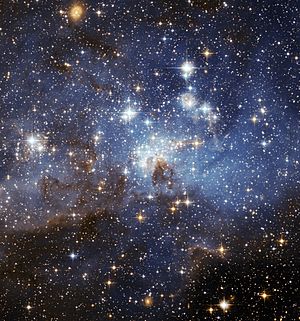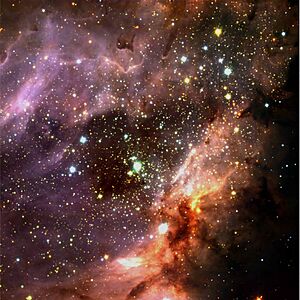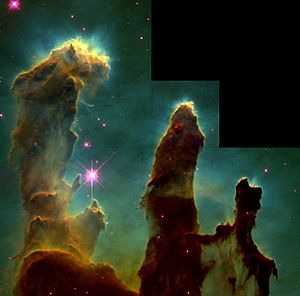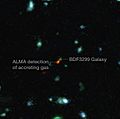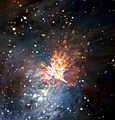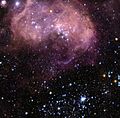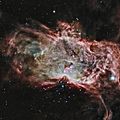Star formation facts for kids
Star formation is how stars are born. It's the very first part of a star's long life. Stars begin in dense, dusty areas of space called "stellar nurseries." These nurseries are giant clouds of gas and dust. Over time, gravity pulls the gas and dust together. As more material gathers, it gets hotter and denser, eventually forming a new star.
Contents
Where Stars Are Born: Stellar Nurseries
Stars are born in special places in space called "stellar nurseries." These nurseries are actually very dense clouds of gas and dust, also known as nebulae. They are found in the space between stars, which is called the interstellar medium.
Giant Molecular Clouds
In the densest parts of these nebulae, most of the hydrogen gas is in a molecular form (H2). Because of this, these nurseries are often called molecular clouds. The biggest ones are known as giant molecular clouds.
These huge clouds can be about 100 light-years wide. They can hold as much material as 6 million of our Suns! Inside, they are super cold, about -263 degrees Celsius (10 Kelvin). About half of all the gas and dust in our Milky Way galaxy is found in these molecular clouds.
Our Milky Way galaxy has about 6,000 of these giant molecular clouds. Each one can form many stars. The closest big stellar nursery to our Sun is the Orion nebula. It's about 1,300 light-years away. Another nearby place where smaller stars are forming is the Rho Ophiuchi cloud complex, about 400-450 light-years away.
Bok Globules
Another type of star-forming spot is called a Bok globule. These are small, dark, and very dense clouds of gas and dust. They were named after the astronomer Bart Bok.
Bok globules are usually about one light-year across. They contain enough material to form a few Sun-sized stars. You can often see them as dark shapes against brighter nebulae or background stars. Scientists have found that more than half of the known Bok globules are actively forming new stars!
Star Formation in Galaxies
Our Milky Way is a spiral galaxy. It's full of stars, old star remains, and the gas and dust of the interstellar medium. This medium is mostly hydrogen and helium. It also has tiny amounts of heavier elements. These heavier elements were made inside stars and then released when those stars ended their lives.
Elliptical galaxies are different. They usually lose their cold gas and dust after about a billion years. This makes it hard for them to form new stars. New stars usually only form in elliptical galaxies if they crash into other galaxies.
W75N(B)-VLA2: A Growing Star
W75N(B)-VLA2 is a huge protostar, which means it's a star that's still forming. It's about 300 times brighter than our own Sun! Astronomers have watched this star grow over 18 years. This helped them understand how very heavy stars are born.
This young star is about 4,200 light-years from Earth. It's surrounded by a cloud of dust shaped like a doughnut.
Scientists first observed it in 1996. By 2015, the strong wind coming from the star changed shape. It went from a small, round form to a larger, stretched-out shape. This change gave scientists important clues about how massive stars form. Being able to see such fast growth is very rare and exciting!
Images for kids
-
The W51 nebula in Aquila - one of the largest star factories in the Milky Way (August 25, 2020)
-
ALMA observations of the Orion Nebula complex provide insights into explosions at star birth.
-
Composite image showing young stars in and around molecular cloud Cepheus B.
-
The Orion Nebula is a great example of star formation. It shows massive, young stars shaping the nebula and pillars of dense gas that might be home to new stars.
-
Young stars (purple) revealed by X-ray inside the NGC 2024 star-forming region.
See also
 In Spanish: Formación estelar para niños
In Spanish: Formación estelar para niños


